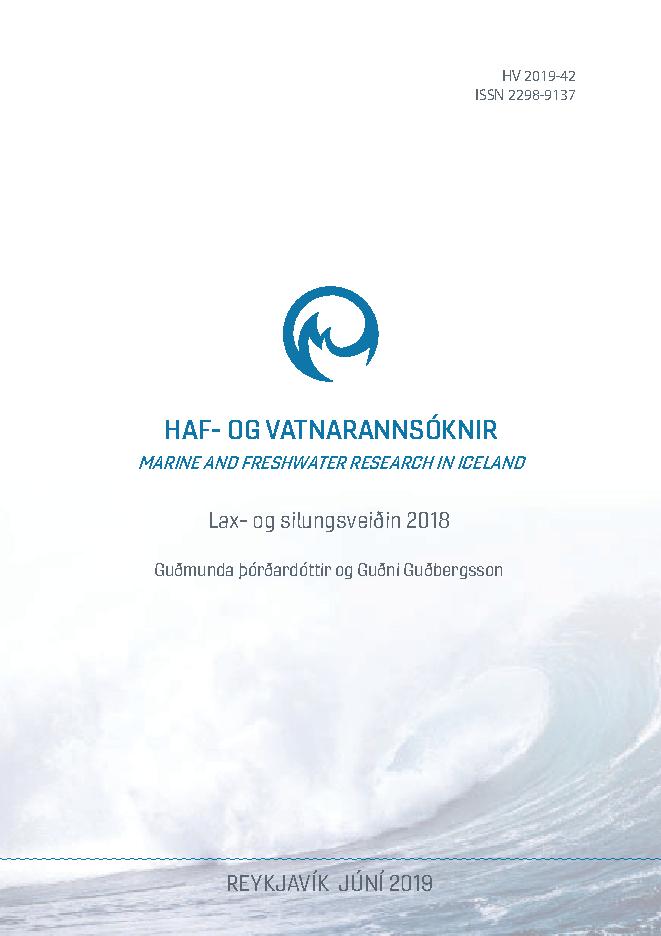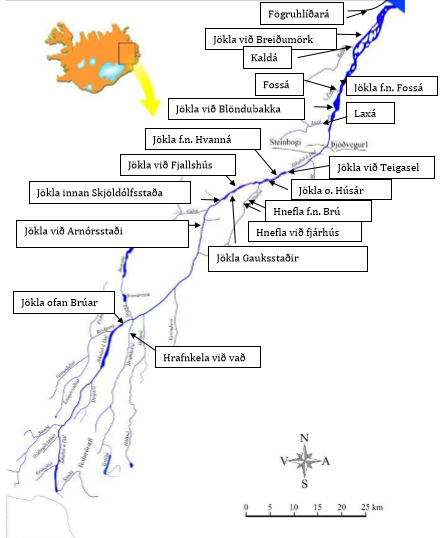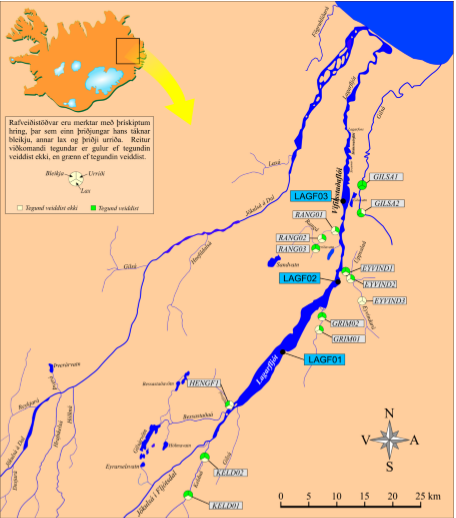Progress
Number and species composition of Arctic char & trout in Lagarfljót River before and after harnessing. Based on the number of fish caught in a standardised experimental fishing project.
The results of experimental fishing using standardized methods in 1998, 2005 and 2006 provide the most accurate information about the baseline condition of trout stocks in Lagarfljót River above Lagarfoss waterfall. According to these, almost one out of four trouts catched is the brown trout.
| Egilsstaðir | Hallormsstaður | Vífilsstaðaflói | ||||
|---|---|---|---|---|---|---|
| Year | Arctic char | Brown Trout | Arctic char | Brown Trout | Arctic Char | Brown Trout |
| 1998 | 228 | 31 | 86 | 42 | ||
| 2000 | 123 | 50 | ||||
| 2005 | 95 | 44 | 46 | 37 | ||
| 2006 | 119 | 49 | 61 | 16 | ||
| 2010 | 15 | 2 | 16 | 11 | ||
| 2011 | 54 | 39 | 24 | 36 | ||
| 2012 | 69 | 29 | 15 | 27 | 38 | 15 |
| 2014 | 51 | 43 | 56 | 63 | 90 | 53 |
| 2016 | 71 | 36 | 59 | 35 | 81 | 48 |
Same kind of experimental fishing was done every second year since 2010. In addition fishing took place by the coast parallel to studies of coastal life in summer of 2011, but data collected there is not comparable except regarding condition of the fish. The catch in the summer of 2010 was less than one tenth of the catch in 2005 and 2006 near Egilsstaðir, but about quarter by Hallormsstaður (LV-2011-044 Icelandic only). ince then the catch has increased but still it is under average compared to the years before the power plant (LV-2013-084, LV-2015-119 and LV-2017-094 Icelandic only).
All the brown trout caught in these experiments has turned out to be local that is spends its lifetime in fresh water instead of migrating to sea. Though it needs further research and findings will be expected from research in the year 2016. Research also indicates that the major part of the fish from the tributary streams is of local stock. Information gathered from fish counter in the fish ladder indicate that the majority of migrating fish is brown trout probably sea trout heading for the sea. It is unclear how many fish go through the fish ladder each year, but research indicates that there are dozens of them rather than hundreds. In 2010, Landsvirkjun made an agreement with the Icelandic Institute of Freshwater Fisheries on tagging fish in the ladder and watching where they go to. Research was repeated in 2011LV-2013-014 (Icelandic only). A total of 27 fish were tagged, 20 brown trout and 4 salmon. While some fish have turned up in Lagarfljót's tributary streams, some have also migrated to the area below Lagarfoss power station. Therefore, there is still much unknown about migration from sea, or the interconnection between areas below and above Lagarfoss waterfall. None of the salmons returned to the river.
Registration of fishing is somewhat lacking, but Lagarfljót Fishing Association considers that the annual trout fishing in the river above Lagarfoss waterfall is about 3,000 fish (based on a survey among landowners).
The research from 2006 and 2007 was continued in 2011 and 2012. A report on the results from 2006 - 2007 will be issued soon. The main factor likely to affect the fauna is increased turbidity because of Jökulsá á Dal river running through Hálslón reservoir.
Species composition and distribution of fish in Jökulsá á Dal river, Lagarfljót river and tributary systems (salmon) (Project effect: indirect).
Figure 1. Map of river basin Jökulsá á Dal. Electrical fishing area is marked with arrows.
Figure 2. Location of electrical fishing points (circle) in the rivers Kelduá, Hengifossá, Grímsá, Eyvindará, Rangá and Gilsá, also net fishing area in Lagarfljót (blue boxes), the year 2014.
| Salmon | ||||||
|---|---|---|---|---|---|---|
| River / Year | 2005 | 2006 | 2010 | 2012 | 2014 | 2016 |
| Kelduá | 0,0 | 0,0 | 0,0 | 0,0 | 0,0 | 0,0 |
| Jökulsá í Fljótsdal | 0,0 | 0,0 | 0,0 | 0,0 | ||
| Hengifossá | 0,0 | 0,0 | 0,0 | 0,0 | 0,0 | |
| Rangá í Fellum | 0,0 | 0,0 | 0,0 | 0,0 | 0,0 | 0,0 |
| Gilsá í Eiðaþinghá | 6,6 | 12,0 | 8,0 | 2,8 | 5,7 | 3,9 |
| Fögruhlíðará | 7,2 | 14,5 | 0,0 | 5,0 | ||
| Laxá í Jökulsárhlíð | 8,2 | 16,2 | 15,2 | 139,1 | ||
| Hrafnkelsá | 0,0 | 0,0 | 3,7 | 0,0 | ||
| Eyvindará | 1,7 | 0,3 | 0,0 | 0,0 | ||
| Arctic Char | ||||||
|---|---|---|---|---|---|---|
| River / Year | 2005 | 2006 | 2010 | 2012 | 2014 | 2016 |
| Kelduá | 1,3 | 4,4 | 3,3 | 3,1 | 4,7 | 9,8 |
| Jökulsá í Fljótsdal | 0,3 | 0,3 | 0,6 | 0,0 | ||
| Hengifossá | 1,0 | 1,3 | 3,5 | 5,9 | 0,6 | |
| Rangá í Fellum | 0,0 | 0,0 | 0,0 | 0,5 | 0,2 | 0,5 |
| Gilsá í Eiðaþinghá | 4,7 | 7,6 | 2,6 | 4,3 | 4,6 | 9,3 |
| Fögruhlíðará | 0,6 | 0,5 | 1,4 | 6,5 | ||
| Laxá í Jökulsárhlíð | 3,0 | 12,5 | 1,0 | 0,0 | ||
| Hrafnkelsá | 0,1 | 0,3 | 0,6 | 0,5 | ||
| Eyvindará | 0,6 | 1,7 | 0,2 | 0,2 | ||
| Brown Trout | ||||||
|---|---|---|---|---|---|---|
| River / Year | 2005 | 2006 | 2010 | 2012 | 2014 | 2016 |
| Kelduá | 0,1 | 2,0 | 3,3 | 3,9 | 2,7 | 1,3 |
| Jökulsá í Fljótsdal | 0,0 | 0,0 | 0,0 | 0,0 | ||
| Hengifossá | 0,0 | 0,4 | 0,0 | 1,2 | 0,0 | |
| Rangá í Fellum | 11,0 | 13,1 | 11,5 | 12,6 | 10,6 | 14,1 |
| Gilsá í Eiðaþinghá | 0,8 | 1,6 | 2,8 | 2,4 | 2,0 | 5,0 |
| Fögruhlíðará | 1,1 | 0,9 | 0,0 | 1,0 | ||
| Laxá í Jökulsárhlíð | 1,9 | 0,0 | 7,4 | 0,7 | ||
| Hrafnkelsá | 0,0 | 0,0 | 0,0 | 0,0 | ||
| Eyvindará | 2,2 | 5,4 | 7,2 | 1,1 | ||
Fingerling condensation index per 100 m2 of riverbed, mean for 2005, 2006, 2010, 2012, 2014 and 2016 (caught with electrical fishing). Note that within each year there can be up to three electric fishing stations, figures reflect the total area of all stations within each year and the total number of juveniles caught.
It must be taken into account that the number of fingerlings in their 1st and 2nd year generally account for 90% or more of fingerlings caught. The number of fish surviving to the age of 3-4 years is a better indication of the production of the river in question, that is, its contribution to the fish stock.
No major changes have taken place in the tributary rivers between these years. Comparisons are somewhat biased by fingerlings added to some rivers, like salmon fingerlings in Hrankelsdalsá river and Eyvindará river.
Updated: December 20, 2018
Source: Reports on fisheries research in the watershed Lagarfljóts, Jökulár á Dal, Fögruhlíðará og Gilsá (Icelandic only) - See reports undir Further reading tab.
Fishing (number of fish) in relevant rivers as registered by the Institute of Fresh Water Fisheries. (Project effect: indirect)
Figure 3. Number of salmons caught with fishing pole in Jökulsá á Dal river basin.
Figure 4. Number of salmons caught in net and recorded at Institute of Fresh Water Fisheries.
Updated: March 5, 2018 - Reviewed December 18, 2018
Source: Guðni Guðbergsson, Lax- og silungsveiðin, 2005-2019.
Metrics, Targets and Monitoring Protocol
What is measured?
- Species composition and condition of fish in Lagarfljót (arctic charr & trout). (Project effect: indirect)
- Species composition and distribution of fish in Jokulsá á Dal, Lagarfljót and tributary systems (salmon). (Project effect: indirect)
- Fishing (number of fish) in relevant rivers as registered by the Institute of Fresh Water Fisheries. (Project effect: indirect)
Monitoring Protocol
- Samples of arctic charr & trout were taken in 2005 and 2006, beforre harnessing was started, and will be taken about once a year until it is clear that the effects of the power station have been revealed. Thereafter, monitoring will be reviewed.
- Will focus on salmon. Electrical fishing will be used to give and index for species composition, density and the status of fish spawning. Samples were taken in 2005 and 2006 to give baseline information before harnessing, and will be taken about once a year until it is clear that the effects of the power station have been revealed. Thereafter, monitoring will be reviewed. Electrical fishing was used in the following locations (rivers):
- Jökulsá á Fljótsdal
- Kelduá
- Rangá
- Eyvindará (added in 2010)
- Jökulsá á Dal, 3 locations (after collection of water into Hálslón Reservoir started)
- Laxá in Jökulsárhlíð
- Fögruhlíd
- Hrafnkelsdalsá
- In addition, two places weree added in Gilsa/Selfljot, outside the immpact area, to use for reference.
(Updated January 17, 2014)
- Fishing organizations give information about the number of fish caught in each river to the Freshwater Fish Agency. The Agency registers the data annually.
Targets
Targets in points a and b are for fish stocks to remain stable in Lagarfljót, Jökulsá á Dal and their tributaries. Objectives are not set in point c where this is not the case, but only monitoring and dissemination of information.
Possible countermeasures
Not applicable, monitoring only.
Changes of indicator
This indicator was originally number 27.1. It was then named Freshwater Aquatic Fauna and can be found under that number in documents of the project from 2005 and 2006.
The indicator number has been changed twice.
| Year | Nr. | Indicator name |
|---|---|---|
| 2020 | 2.5.4 | Freshwater Ecology in Jökulsá á Dal and Lagarfljót. |
| 2007 | 2.25 | Freshwater Ecology in Jökulsá á Dal and Lagarfljót. |
Baseline
The cold temperature of the two glacial rivers, Jökulsá in Fljótsdal and Jökulsá in Dal, provide good conditions for aquatic life. Jökulsá in Dal contains the highest sediment load of the glacial rivers in Iceland. Fish can swim into Jökulsá in Fljótsdal 25 km further than Logurinn but biological productivity is low because of floods and low concentration of dissolved chemicals. Suspended sediment in Lagarfljot river limits biological productivity to the top layers of the water. The impacts of the glacier are greatest closest to Jökulsá in Fljotsdal and are less closer to the shore. Both mountain trout and brown trout can be found in the Lagarfljot River. Net fishing in the river has yielded up to 1,000 kg of fish per year in recent years. Salmon fishing with nets in Lagarfljot River downstream from Lagarfoss and annual catch in the period 1985 to 1999 was 87 salmon.
Knowledge of the basic condition of trout stocks in Lagarfljót is based on standardized research (experimental fishing) at each end of the river in 1998, 2005 and 2006. Experimental fishing in the north in the summer of 2000, i.e. in Vífilsstaðaflói, gave similar results. On the basis of these results, it is not easy to draw strong conclusions about fluctuations in the stock, but in this connection it is natural to take into account variability that could be due to circumstances during the study period, e.t.v. 20-30%.
| Egilsstaðir | Hallormsstaðir | |||
|---|---|---|---|---|
| Year | Arctic char | Brown Trout | Arctic char | Brown Trout |
| 1998 | 228 | 29 | 92 | 37 |
| 2005 | 95 | 44 | 46 | 37 |
| 2006 | 119 | 50 | 61 | 17 |
| Alls: | 442 |
123 | 199 | 91 |
| Meðaltal: | 147 | 41 | 66 | 30 |
| Hlutfall %: | 78 | 22 | 69 | 31 |
Biological productivity in Jökulsá in Dal is also limited. Conditions for fish are poor because of the amount of suspended sediment, changes in discharge, and unsuitable substrate for fish spawning. This has resulted in very little fishing in Jökulsá in Dal. However, the projects are expected to have positive effects on biological productivity in the river. As for the most part of the year, water with low nutrients are now diverted away from the river, it can now benefit from water high in nutrients, from the moors. It is not clear if this change will lead to an increase in number of spawning areas since the bottom of the river is currently mostly rock or mud that is not suitable for spawning.
The tributary streams usually join the main rivers in canyons which makes it difficult or impossible for fish to swim up those streams. Four rivers are in Jokulsarhlid and three of those join Jökulsá in Dal, including Kaldá, Fossá and Laxá. Some recreational fishing takes place in Keldua, mainly for mountain trout. Average annual fishing catches in Keldua in the period 1997 – 2001 was 138 mountain trout, 27 brown trout, and 1 salmon.
Source: Institute of Freshwater Fisheries
Rationale for Indicator Selection
The Kárahnjúkar project will have great impact on hydrology. However, this will not automatically lead to changes in freshwater aquatic fauna since the cold temperature in the two glacial rivers, Jokulsa in Fljotsdal and Jokulsá in Dal, limits biological activity. The fauna in Jokulsá in Dal and its tributary streams in Jokulsárhlid, Lagarfljót and Kelduá is not very diverse and the rivers a not been used much for fishing. The impact of the dam will depend largely on changes in discharge of the rivers and an increase or decrease in sedimentation. It is possible that the effects in Jokulsá in Dal will to some degree be positive, i.e. biological productivity could increase.
From phase I/II report on indicators and baseline from April 2005
Further reading

Lax- og silungsveiðin 2019. HV 2020-38
Laxveiði á stöng árið 2019 var sú minnsta á síðustu 20 árum og sú sjöunda minnsta frá árinu 1974. Talsverður munur var á milli landshluta og samdráttur í veiði mestur á Vesturlandi en veiði í ám á Norður og Austurlandi var svipuð og var árið 2018. Minni laxagengd og laxveiði á Vesturlandi og Suðurlandi árið 2019 skýrist að miklu leyti af óhagstæðum umhverfis aðstæðum þ.e. lítilli úrkomu og hlýindum. Ár voru vatnslitlar sem gerðu fiskum erfitt fyrir í uppgöngu og veiðimönnum við veiðar. Stangveiðin sumarið 2019 var samkvæmt skráningu á laxi í ám á Íslandi alls 29.218 laxar.
You can view more material related to the indicator by clicking on the link above.


